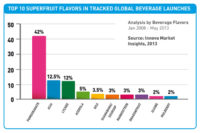Tea and ready-to-drink (RTD) tea achieved estimated sales of $6.7 billion this year, according to Chicago-based market research firm Mintel. And according to Rockville, Md.-based Packaged Facts, sales are expected to grow to nearly $8 billion by 2014, said Douglas Rash, group vice president of global sales for Treatt, Lakeland, Fla., in a statement.
“As more and more consumers learn the health benefits of various teas, more tea drinkers are constantly coming on board, raising the consumption rate per capita to new heights every year,” says John Wilson, marketing manager for Allen Flavors Inc., Edison, N.J. “RTD teas have followed the same trend from the beginning. This is largely due to convenience, but there are recent trends indicating that functional teas, which include vitamins, additional [epigallocatechin gallate] (EGCG), grape seed extracts, antioxidants and, of course, the comfort of non-tea flavors such as peach, raspberry or superfruits, [are] pushing the consumption rate up as well.
“Beyond our U.S. borders, we are seeing an explosion in popularity of RTD teas in countries that have traditionally consumed only hot tea for centuries,” Wilson continues.
The consumption of iced tea, in particular, is increasing rapidly in the United States, and growth is projected to grow steadily for the next five years, says John Harper Crandall, vice president of sales for Amelia Bay, John’s Creek, Ga., citing market research and internal sales data.
“This growth is due to a shift in consumer preferences away from soft drinks and bottled water to beverages that are perceived as healthy and functional,” Crandall explains. “Consumers want more from their beverages than just hydration or calories. They want great, satisfying, functional beverages that offer more than just refreshment. Tea is perceived in the industry as a healthy alternative.”
Steve Wolf, director of flavor applications for Robertet Flavors, Piscataway, N.J., notes that tea almost could be classified as a natural sports drink because it contains healthful ingredients and caffeine.
More than 5,600 scientific studies on the health benefits of tea have been conducted recently, as was reported at the 2012 U.S. Department of Agriculture’s fifth annual conference. “These studies link tea with cardiovascular health, cognitive improvement, cancer prevention, weight management, stress reduction, etc.,” says Anton Angelich, group vice president of marketing for Virginia Dare, Brooklyn, N.Y. “The most recognized health-associated component in tea are the polyphenols — antioxidants.”
However, greater amounts of polyphenols in a beverage can result in greater astringency, which can be unappealing to consumers if the levels are too high, suppliers note.
The healthful polyphenols in tea also are responsible for turbidity and sedimentation in a finished beverage, which can detract from the visual appearance of the product, says Dan Wampler, president and founder of Wauconda, Ill.-based Synergy Flavors. Additionally, the sedimentation can become a plugging issue for dispensers in the foodservice industry, he adds.
Research conducted by Virginia Dare also found that two-thirds of consumers would prefer not to have tea solids settling in their RTD tea beverages. A new proprietary brewed tea concentrate from Virginia Dare incorporates tea flavor, top notes and solubilized tea solids into one concentrate to eliminate tea solids at the bottom of a finished beverage while delivering full body mouthfeel and desirable astringency, Angelich says.
Similarly, Amelia Bay recently introduced its concentrated liquid tea solids extract, which can provide a considerable amount of tea solids without sedimentation or clouding problems, Crandall says. It also has the ability to replace caramel color, if desired, he adds.
Tea types
To accommodate the increased interest in the benefits of tea, beverage-makers are producing a variety of tea drinks using different types of tea, such as black, green, oolong and white.
This year, Allen Flavors launched a line of uncommon tea varietals called TeaMates. The line includes rooibos, pai mu tan and honeybush teas that offer exotic taste profiles, Wilson says. The company also launched its TeaEssentials collection, which consists of six proprietary essence blends with balanced, unique flavor profiles including hay, leaf, caramel and candy in styles of brewed, green, sweet or fresh, he adds. The line also includes a 100 percent organic tea essence blend that delivers a creamy, fresh character, he notes. A new SpecialTeas essence collection offers a full flavor experience for green, black and sweet tea types, he says.
Consumer preferences for tea are becoming increasingly varied, Treatt’s Rash said in a statement. The Tea Council in the United Kingdom estimates that there are now more than 1,500 varieties of the Camellia sinensis tea plant, but black and green tea varieties remain the most popular, he added.
Suppliers note that black tea is the No. 1 most popular tea in the United States followed by green tea. Amelia Bay’s Crandall expects these varietals to continue to dominate the segment for the next five years.
“While it was thought that white tea and oolong teas would be the next big thing, it appears that the bulk of the tea market is still focused on black and green tea,” says Gary Vorsheim, vice president of extract sales for Martin Bauer Inc., Secaucus, N.J.
Nonetheless, Synergy Flavors’ Wampler says the company has put a focus on oolong teas because of their increasing popularity. White tea's favor, however, seems to be fading in the United States, Robertet Flavors’ Wolf says.
Although green tea has increased in popularity throughout the years, its taste lacks the widespread appeal of black tea, Virginia Dare’s Angelich says. Some consumers detect undesirable grassy or sulfur-like taste notes, he explains. To offer a solution, Virginia Dare has incorporated varietal apple flavors from its apple flavor collection to enhance the taste of green-tea-based beverages and widen the franchise of green tea beverage consumers.
“As tea consumption is increasing, consumers are becoming more sophisticated in their interests in tea,” Angelich adds. “With a growing abundance of specialty tea shops and gourmet sections of supermarkets, consumers have greater choices in tea blends, tea terroir selections and flavored teas.”
The origin or terroir of tea is beginning to interest consumers, Amelia Bay’s Crandall says. Therefore, origin claims will develop in the coming years, he says; however, organic and Fair Trade claims might not be as popular. Although organic products continue to hit the market, both organic and Fair Trade claims have been on the decline in recent years, he explains. A natural claim, however, seems to be the most cost-effective and popular way to differentiate a product for health-minded consumers, he says.
Favorite flavors
Consumers’ expanding tea options don’t end with origin or ingredient claims; they also extend into flavors.
In the last few years, companies have been asking for a more authentic-tasting tea, Martin Bauer’s Vorsheim says. Therefore, the company launched a line of tea extracts called Strong Tea Infusions. The extracts are made from higher-quality leaf teas and are processed at lower temperatures to protect the tea flavors, Vorsheim explains. Additionally, the company has minimized the amount of further processing to maintain the authentic tastes associated with the leaf tea used for the brew, he says.
For iced tea drinks, Vorsheim notes that stronger tea taste will become a higher priority for beverage producers in order to provide a point of difference between brands, to meet consumers’ desires for tea products with a truer taste, and to obtain higher levels of the healthful ingredients found in tea, which is a main reason for many consumers to drink tea.
To bring out a specific tea flavor, Robertet Flavors developed Tea Accords. “What that allows us to do is rather than just having a single tea character, it allows us to emphasize portions of the tea character as needed,” Wolf explains. For instance, the company can add the brewed or roasted notes from a black tea flavor to emphasize those specific characters.
Wild Flavors recently launched its ImmuniTea concept that contains a natural Tahiti lime tea flavor, Immunel for immune support and a natural sweetness enhancer enabling lower calories without the use of high-intensity sweeteners, says Stephanie Weil, product manager for the Erlanger, Ky.-based company. On the opposite side of the flavor spectrum, the company launched a deflavored green tea catechin extract for use in applications where the health benefits of tea are desired but the tea profile is not.
“In addition to the health factors of tea, consumers seem to be shifting toward a desire for less sweet and unique flavors, both of which fit nicely into the tea category,” she says.
With the increased demand for low-calorie drinks, the combination of sweeteners including sugar, stevia and artificial sweeteners is increasing, Robertet Flavors’ Wolf says.
Popular fruit flavors and a majority of sweeteners also complement the smooth, mild taste of black tea, Martin Bauer’s Vorsheim says. “While green tea is a little more limiting in its ability to work with a wide range of flavors, as the market has developed, the use of new fruit flavors has provided more options for consumers to choose from, resulting in an elevated level of consumption,” he continues.
Most often, however, green tea is associated with honey and ginseng, Robertet Flavors’ Wolf notes.
Traditional flavors such as lemon, peach, raspberry, citrus and plain tea have survived the test of time; however, many beverage companies are seeking alternative flavors that aren’t typically associated with tea, such as pineapple, apple, mint, strawberry, chocolate and herbal ingredients, Vorsheim says.
Wild Flavors’ Weil agrees, saying, “New flavor varieties in all beverages are important as consumers seek interesting and unique flavors embedded in familiar products. Expect to see fruit varietals, blends of botanicals and herbs, and seasonal flavors prosper in tea beverages.”
Wild Flavors expanded its range of exclusive tea ingredients with its acquisition of A.M. Todd last year. The company offers exotic flavor blends such as Tropical Tulsi Tea, Yumberry Black Tea, Goji Berry Green Tea, Pear Mangosteen Rooibos Tea, Blueberry Lemonade Black Tea, Strawberry Lemonade Green Tea and Pomegranate Cherry Cinnamon White Tea.
“There has been a steady growth in the incorporation of tropical and exotic superfruits and superfruit flavors in functional tea beverages for a number of years now,” Virginia Dare’s Angelich says. “With newer consumer interests in food security, reduced carbon footprints, and locovore and sustainable supply, there has been a shift in the superfruit paradigm. Native and domestic superfruits such as tart cherry, blueberry and raspberry are surely gaining in new product flavored tea product introductions.”
Thomas Schufreider, vice president of marketing and business development for Synergy Flavors, adds that blackberry, passion fruit, tropical and mandarin orange flavors also are gaining fast acceptance. Additionally, creamy vanilla flavors reminiscent of a Thai iced tea or milky chai tea are popular, says Bill Smith, applications manager for Synergy.
In the United States, tea is most often paired with lemon or milk, Robertet Flavors’ Wolf says. However, in England, tea is almost always paired with cream or a dairy product, and in India, tea is usually consumed as chai, which combines tea, milk and a variety of spices, he explains. Robertet is experimenting with both of these global tea combinations in the United States.
For tea drinks just coming to the market, Amelia Bay’s Crandall suggests blending tea with a traditional flavor like peach or raspberry. For a line extension to an established blend, however, he recommends something slightly different, such as green tea with Valencia orange. “If it’s too weird, there is a chance your typical consumer might pass it up,” he says.
Generally speaking, strong flavors that can override bitterness work well in tea drinks, says Randy Kreienbrink, director of marketing for BI Nutraceuticals, Long Beach, Calif.
“Some of the teas that may be more bitter will work well with something that can override the bitterness with a stronger flavor like raspberry or strawberry,” he says. “Peach as well, because it has a sweetness factor.”
Although botanical ingredients do not come from the tea plant, suppliers note that they are becoming more mainstream in the tea category.
“The use of herbals with tea is growing in momentum, albeit in premium beverages for the most part, but in time we will see a move in this direction by the value brands as well,” Martin Bauer’s Vorsheim says.
Specializing in botanical ingredients is BI Nutraceuticals. Kreienbrink notes that the most appealing functional benefits of tea to consumers are its antioxidant, calming, energy, mental acuteness and joint health properties. Green tea and botanicals such as chamomile, guarana, kola nut extract, ginseng and ginkgo biloba can be incorporated into RTD teas or tea bags to achieve such added properties. BI








